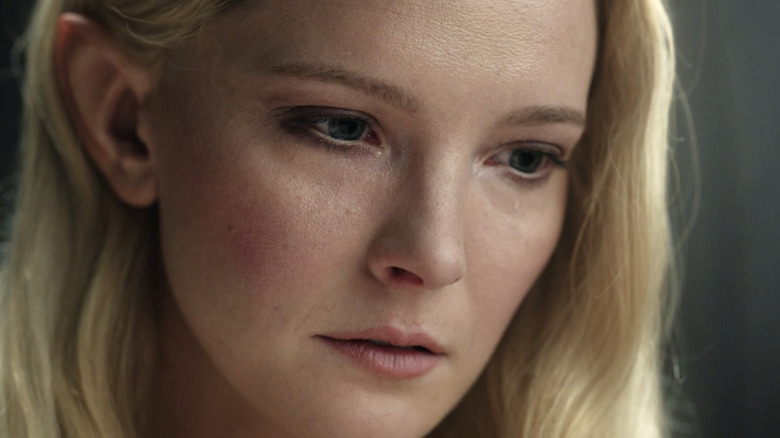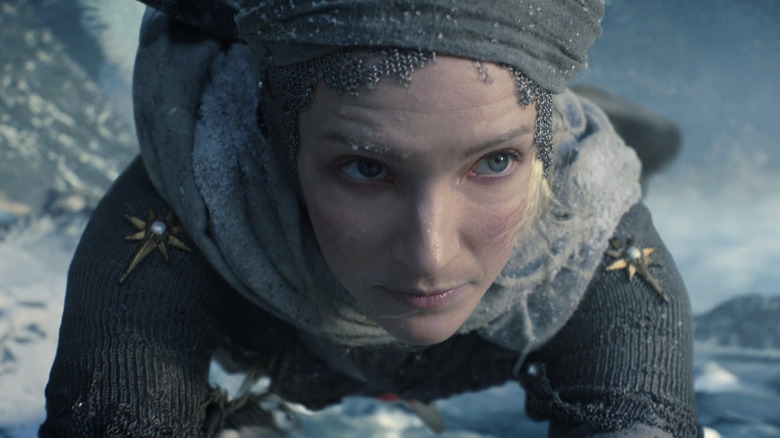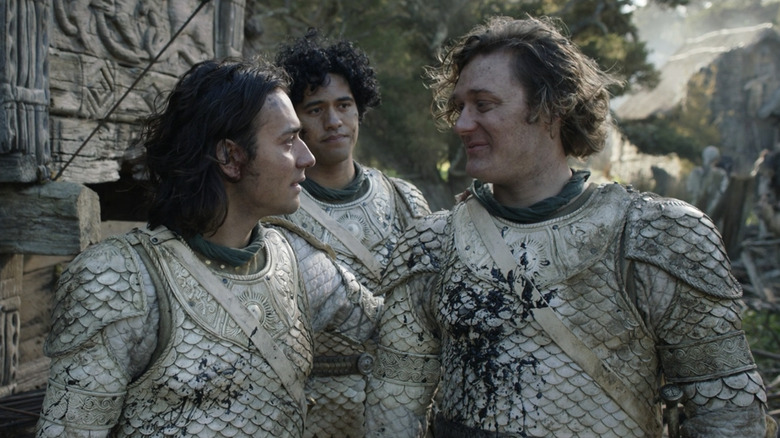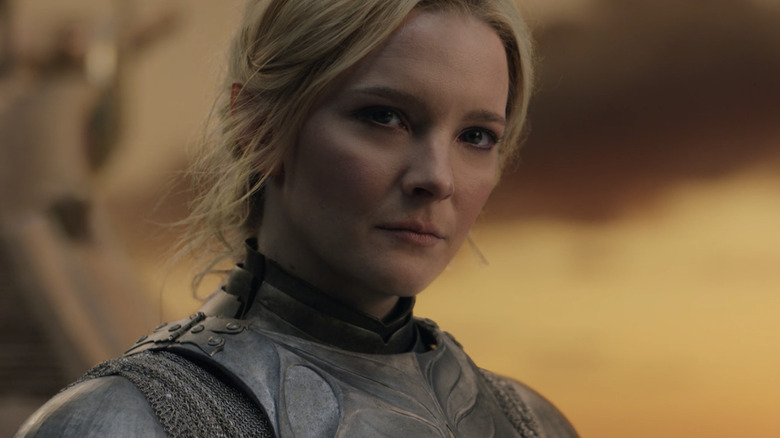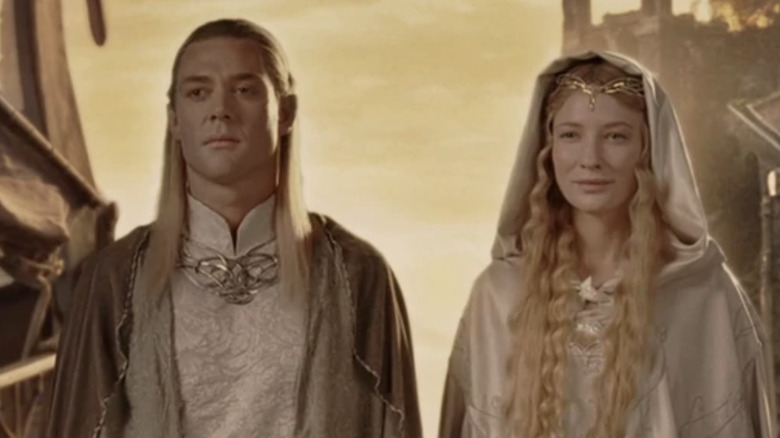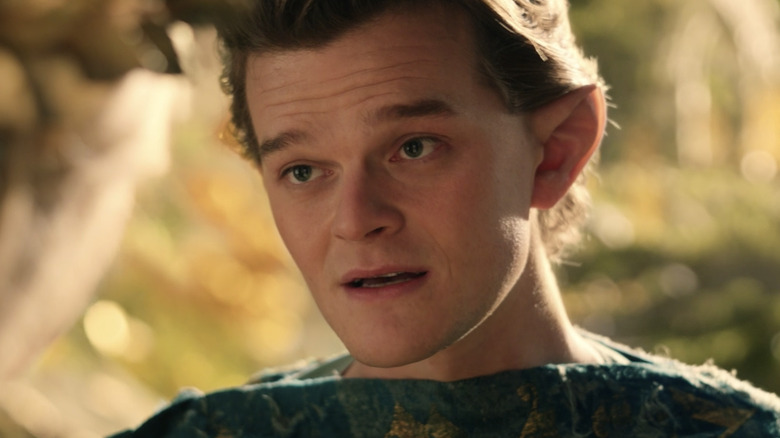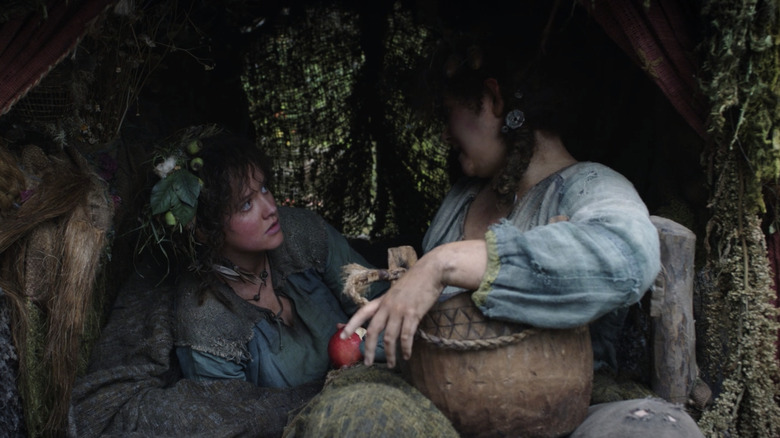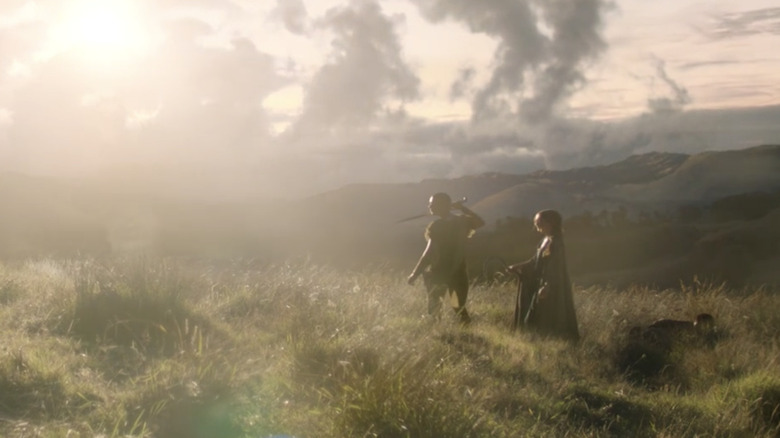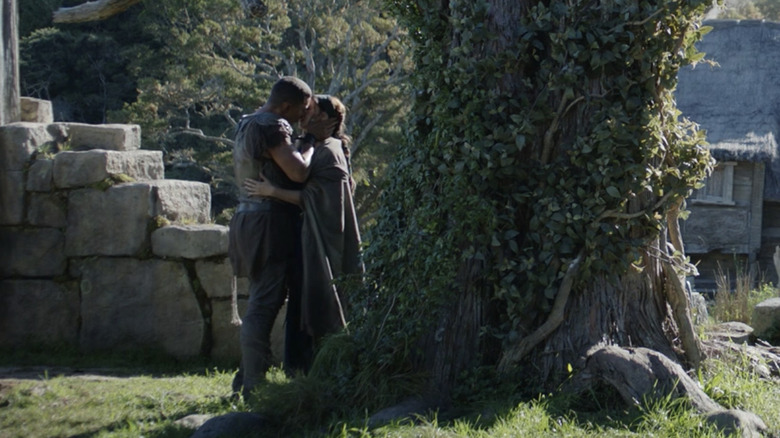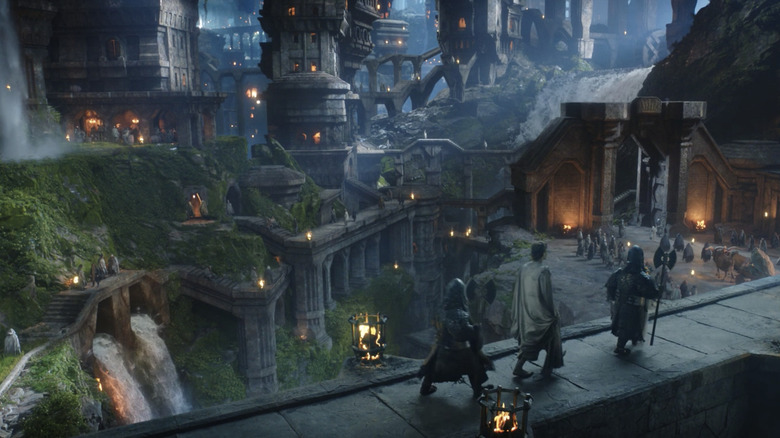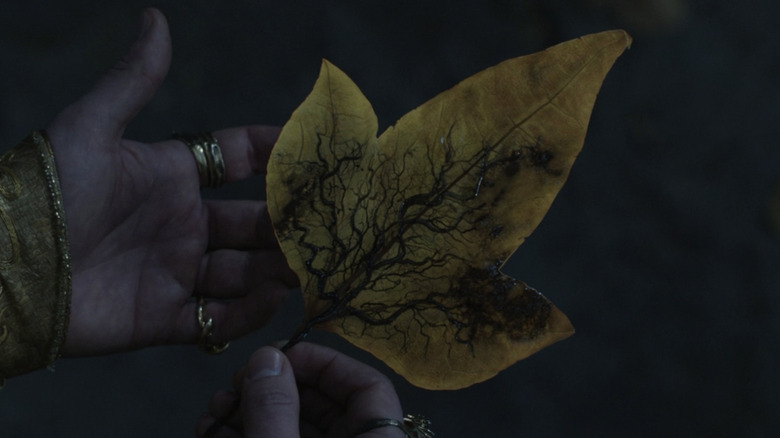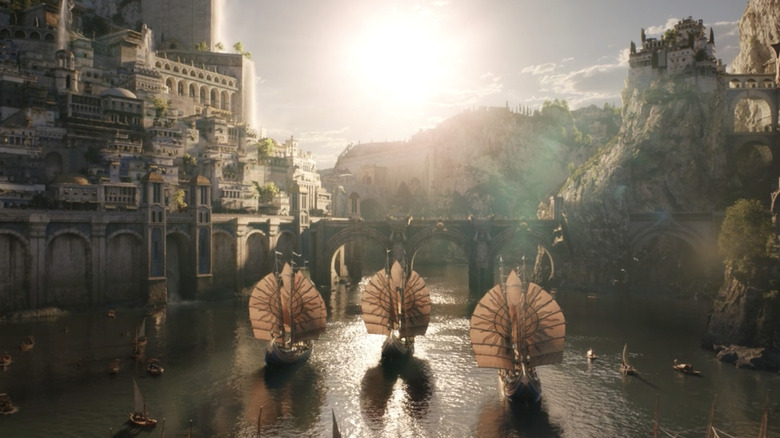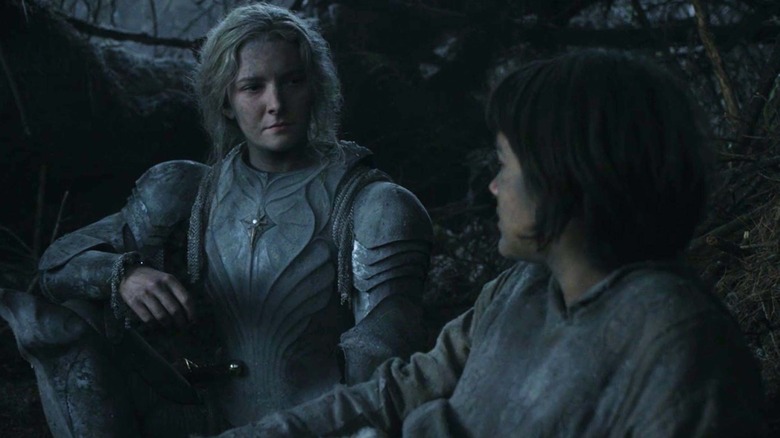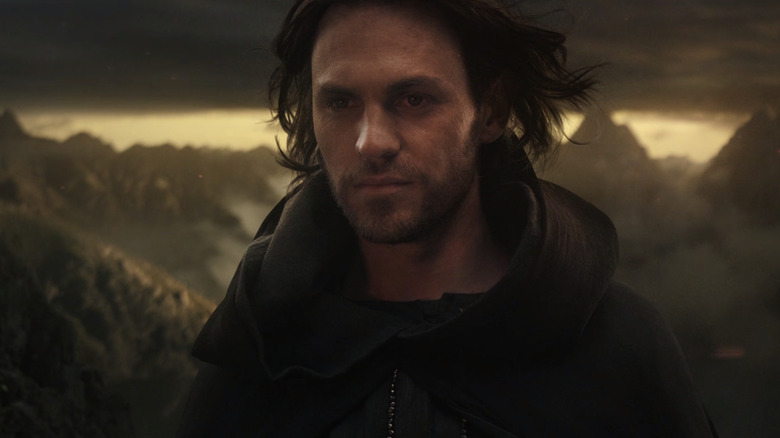The Biggest Differences Between The Rings Of Power And The Lord Of The Rings Movies
After years of fans eagerly anticipating an epic return to Middle-earth, Amazon's iteration of the world of J.R.R. Tolkien's "The Lord of the Rings" has been released in the form of the prequel series "The Lord of the Rings: The Rings of Power." Following some familiar elven characters and others who didn't originate from the books at all, "Rings of Power" has been an exciting whirlwind that challenges everything we know about Tolkien's high-fantasy world. Of course, not everyone loves all the new changes — or the departures from Peter Jackson's definitive trilogy — while others have waited on the edge of their seats for a time such as this.
While the visions behind Jackson's "Lord of the Rings" films and the J. D. Payne and Patrick McKay-helmed "Rings of Power" are different, they each derive from the same source material. The latter is currently only authorized to adapt from Tolkien's "The Hobbit" and "The Lord of the Rings" books — as well as the appendices from "The Return of the King" which dive deeper into the Second Age of Middle-earth. This means that the familiar tale of the War of the Ring won't be covered this time around, but that's probably a good thing.
While they're telling very different stories set in two different ages, both Jackson's trilogy and Amazon's new series share a lot of common ground, though not everything is the same. Here are some of the biggest differences between "The Rings of Power" and "The Lord of the Rings" trilogy.
Spoilers for "The Rings of Power" Season 1 lie ahead.
The cast and crew
It's no secret that Peter Jackson's "The Lord of the Rings" trilogy is one of the most beloved in all of cinema. Meanwhile, Amazon's "The Rings of Power" is the most financially ambitious television series of all time. Yet, though these great works are both connected by J.R.R. Tolkien's epic legendarium, those involved behind the scenes are not the same.
While Peter Jackson co-wrote and directed "The Lord of the Rings" and "The Hobbit" trilogies, Patrick McKay and John D. Payne are the showrunners behind "The Rings of Power." Early reports stated that Jackson was originally supposed to be involved in some capacity, only for those plans to fall through (via The Hollywood Reporter). As for the cast, Cate Blanchett and Hugo Weaving, who played Galadriel and Elrond in all six of Jackson's Middle-earth saga films, did not return to play their respective elven characters in this prequel series. Instead, newcomers Morfydd Clark and Robert Aramayo play Galadriel and Elrond, and do so very well.
Likewise, the opening of "The Fellowship of the Ring" movie chronicles where "The Rings of Power" is eventually headed — the Last Alliance Between Elves and Men where Middle-earth makes its final stand against the Dark Lord Sauron. Aside from Weaving's Elrond, it features Mark Ferguson as Gil-galad, Peter McKenzie as Elendil, and Harry Sinclair as Isildur. On the Amazon series, these roles are played by Benjamin Walker, Lloyd Owen, and Maxim Baldry respectively.
A different age
Given that "The Rings of Power" is a prequel, it's obvious that the series takes place in a different time period than "The Lord of the Rings," or even "The Hobbit." But what may be a bit less obvious to viewers is how far back in Middle-earth's past it's actually set. The story of Frodo, Sam, Aragorn, and the Fellowship begins at the very end of what is called the Third Age of Arda, and journeys into the beginning of the Fourth Age.
For the sake of context, "The Rings of Power" condenses the story of the Second Age — which, in Tolkien's original writings, spanned over the course of 3,000 years — into a quicker series of events set thousands of years before Sauron's return to Middle-earth in "The Lord of the Rings." The landscape of Middle-earth looks a bit different in the Second Age than it does later on during the War of the Ring, specifically because Mordor is not yet Sauron's domain. Beyond that, there are some interesting changes.
For one, Elves and Dwarves aren't as hostile towards one another in the Second Age as they are in the Third, and they actually work together to craft some of the most important objects in Middle-earth. We see this clearly in the friendship between Elrond and Prince Durin IV on "The Rings of Power," which is a refreshing sight given the usual malice between races.
Galadriel, elven warrior
We all know Galadriel from "The Lord of the Rings" as a mythic elven queen who wears her own ring of power — the White Ring of Water called Nenya — and easily one of the most powerful characters in all of Middle-earth. Yet, "The Rings of Power" tells the story of a much younger Galadriel — one who isn't quite the elderly stateswoman we know from Tolkien's high-fantasy masterpiece.
That's right — the woman noted for gifting the Fellowship fancy new weapons in Tolkien's original works and Jackson's six-film saga is an Amazonian-like warrior in this prequel series who has yet to take on her role as the mythic guardian of light. On a quest of revenge on Sauron for the murder of her brother Finrod, Galadriel has become a tempest, something that she's beginning to grow out of on the show. This was most notable in the wisdom she imparts to the young Theo in Episode 7, "The Eye," as she reflects on her unforgiving rage.
One of the most notable Galadriel scenes in Jackson's trilogy is when she is tempted with the One Ring by Frodo, but she passes the test. This Galadriel, though still thousands of years old, has yet to gain the strength of character that she will need to forgo Sauron's greatest weapon and choose the righteous path. As we watch her grow into a stoic eleven queen, it's exciting to see where Galadriel came from so that we can better appreciate where she's going.
Where is Celeborn?
One of the biggest changes that "The Rings of Power" makes to both J.R.R. Tolkien's original work and Peter Jackson's films is the exclusion of the wisest of the Elves — Celeborn the Lord of Lothlórien. In Jackson's trilogy, Celeborn and his wife Galadriel aid the Fellowship of the Ring after Gandalf's death and provide them with the support and provisions they need to continue their journey. In the books, the elven pair eventually lead an assault on Sauron's fortress Dol Guldur and destroy it during the War of the Ring.
But it isn't until the seventh episode of "The Rings of Power" that Galadriel finally mentions her husband, and we quickly understand why. She believes that Celeborn died a thousand-ish years ago in the war against Morgoth. While we don't know if Celeborn actually perishes during these events (though it seems unlikely), he's traditionally a part of Galadriel' story during the Second Age, making his absence here pretty notable.
It's possible that Celeborn will make himself known eventually on the show, but because of the changes to the timeline, we're not exactly sure how that could be. Christopher Tolkien once said, "There is no part of the history of Middle-earth more full of problems than the story of Galadriel and Celeborn, and it must be admitted that there are severe inconsistencies 'embedded in the traditions.'" It seems like "The Rings of Power" is working to flesh this inconsistency out.
Elrond is excluded from high councils
The version of Elrond that we know and love from "The Hobbit" and "The Lord of the Rings" movies — played masterfully by Hugo Weaving — is well known for forming the Council of Elrond and for being an active member of the White Council early on, but that isn't his role in "The Rings of Power." At least not yet. Though we know Elrond as the Lord of Rivendell and a gracious host, his younger self — played on the Amazon series by Robert Aramayo — is more of an up-and-coming "politician."
A bit more jovial than his feature film counterpart, Amazon's Elrond fights to protect and support his friends, namely Galadriel and Prince Durin IV, who both tend to be a bit stubborn. Though he's been entrusted with working alongside the great elven-smith Celebrimbor, Elrond is still excluded from the High-Elven Councils run by High King Gil-galad, reminding us — and the elf himself — of his lowly place in this story.
This is unfamiliar territory for many Tolkien fans, as we're used to an Elrond who is not only a part of the club, but often creates the clubs himself. While there's no doubt that Elrond will rise to prominence in elven society and eventually go on to found Rivendell, right now he's still working his way through the ranks.
Hobbits with no home
In both "The Lord of the Rings" and "The Hobbit," it's made abundantly clear that Hobbits live safely in the Shire and prefer to not travel far beyond their own borders. In fact, most Hobbits don't travel at all, instead opting to live cozy, safe, and adventure-free lives in their little Hobbit-holes. Of course, both Bilbo and Frodo Baggins are the glaring exceptions who venture out to enchanted mountains and back again, but this isn't exactly the norm concerning Hobbits.
On the other hand, the Harfoots — ancestors of the Hobbit folk from the Second Age — are a nomadic people, always on the move. These Harfoots travel across Middle-earth in secret, hoping to avoid both attention and adventure along their migration path. While this avoidance is still true of Hobbits in the Third Age, the constantly traveling lifestyle of the Harfoots is a far stretch from the Hobbit society we recognize from the Peter Jackson films.
While Bilbo, Frodo, and Samwise Gamgee are usually our main points of reference for Hobbit culture and adventure, Nori Brandyfoot and Poppy Proudfellow are our gateways into the world of the Harfoots. Nori, whose knack for adventure sets her apart from the rest of the Harfoots, is unlike our usual Hobbit protagonists as she's always getting herself into trouble. Her personality scans as closer to Pippin than Frodo. Still, even though these proto-Hobbits don't yet have a home, there's hope that they will one day discover a land to call their own.
A mankind-inhabited Mordor
In Peter Jackson's films, the dark shadowlands of Mordor are the domain of the Dark Lord Sauron himself. Having once forged the One Ring of Power in the volcanic ash of Mount Doom, Sauron wages war with Middle-earth at the end of the Second Age, only to be defeated. Yet, his kingdom remains, with orcs and goblins at large and still vastly loyal to their old master. In "The Rings of Power," Sauron has yet to do any of this, and the lands that he will eventually inhabit are now ruled by Men, though not for long...
The Southlands, as they're called during this time, are primarily the homeland of a race of Men who once sided with the Dark Lord Morgoth, Sauron's own master. While these people have been free of Morgoth's influence for centuries, a group of Elves — including Arondir — have been stationed in the Southlands to keep evil at bay. This may have been especially necessary, as a few Men still loyal to Sauron remain.
Unfortunately, besides the evil Men, there is also a band of Orcs led by the Dark Elf Adar who fight to take these lands for their own. While "The Lord of the Rings" films show us a dark and depressing Mordor, the Southlands of "The Rings of Power" still have some light left, even if it grows more covered by a blanket of smoke with each episode.
A new kind of Human-Elf love story
Speaking of the Southlands, one of the biggest differences between Peter Jackson's "Lord of the Rings" and Amazon's hit series is paradoxically something they have in common: a love story between a human and an Elf. Of course, we all know of the undying love between Aragorn and Arwen in "The Lord of the Rings," but "The Rings of Power" takes this in a completely different direction. In the show, an Elf named Arondir has fallen in love with a human woman of the Southlands named Bronwyn.
To make matters a bit more difficult, besides the fact that the Orcs' invasion leaves basically no room for romance, Bronwyn has a son named Theo who doesn't particularly like his mother's elven crush. Sadly, Theo isn't the only one who isn't fond of the interspecies couple, and many of the other townsfolk have voiced both disgust and disapproval of the two of them, even if it's just in stares and upset glances. Aragorn and Arwen never saw this kind of backlash, despite Elrond's often vocal disapproval of the pair.
Arondir and Bronwyn are an interesting couple, and as their bond continues to grow, more and more folks in Middle-earth, including Theo, begin to accept them. As they fight for their home in the Southlands, they yearn for a day when they can settle down together in peace, though it might be a long while before they get there.
Dwarves at their peak
In both "The Lord of the Rings" and "The Hobbit" trilogies, we encounter Dwarves who don't quite have a kingdom to call their home. In Peter Jackson's "Hobbit" films, Thorin Oakenshield's company desires to reclaim their homeland of Erebor beneath the Lonely Mountain. Despite their success, we never get to see this Dwarven kingdom at its peak, aside from a flashback or two. Likewise, when the Fellowship arrives at Khazad-dûm, Gimli is shocked to discover that the Dwarven kingdom of Moria has been overrun by Orcs.
In "The Rings of Power," Khazad-dûm is at the height of its prominence. With vast mining operations, beautiful scenery, and a homey culture, what we see of the Dwarves here is unlike anything we've previously experienced in any other live-action adaptation of Tolkien's world. A clear upgrade from its dark and dingy appearance in "The Fellowship of the Ring," Khazad-dûm is a mountain paradise full of color, light, and life. It's pretty incredible to see.
With the introduction of the Dwarves' way of life, Prince Durin IV and his wife Disa have become some of the best characters on the show, marking the first time we've seen a fully Dwarven family portrayed on screen as well. Though Gimli once described Dwarf women as looking similar to Dwarf men, Disa does not, in fact, have a beard, which is only a tad disappointing...
The immortality of the Elves
In Peter Jackson's "The Lord of the Rings," the immortality of the Elves is rarely in question. Though they can clearly die in battle, if unharmed, the elven race can live for multiple millennia before sailing to the Undying Lands of Valinor. The exception to this, of course, is Arwen, the daughter of Elrond, who falls in love with the mortal man Aragorn. In choosing to marry Aragorn, Arwen surrenders her immortality. For the Elves of Middle-earth, death is a conscious choice in many ways.
In contrast, "The Rings of Power" introduces the concept that the Elves can not only die, but that their lifespans are shortening due to a dark corruption that has begun to reach its way to the elven kingdom of Lindon. For characters like Elrond, Galadriel, and even the High King Gil-galad — who we all know will survive the majority of the series — this heightens the stakes while also giving a clear explanation for the elven use of mithril — a silvery metal that is both stronger and lighter than steel.
With the Elves' immortality now in question and a looming shadow growing across their lands, "The Rings of Power" departs even further from the version of Middle-earth we know from "The Lord of the Rings" movies, but in a way that brings excitement and intrigue into this strange fantasy world.
Númenor and the Great Sea
Peter Jackson's trilogy takes place during the Third Age of Middle-earth where Sauron rules the lands of Mordor, Gondor is without a true king, the Elves are beginning their retreat to Valinor, and the Hobbits live happily and safely in the Shire. As Frodo Baggins and his companions make their way from Rivendell to Mordor, they travel all across the lands of Middle-earth and see much more of the map than they ever knew was there. Likewise, in Jackson's "Hobbit" trilogy, Bilbo and the Dwarves travel to the northern parts of the map, avoiding the Great Sea completely.
Due to the differing time period of "The Rings of Power," the series not only takes many of its main characters across the Great Sea, but directly to the island kingdom of Númenor. This sea-faring kingdom is a completely different world of Men than that of Rohan or Gondor, with its own highly developed culture, religion, and armada ready for war. As the Númenoreans brave the Great Sea to help liberate Middle-earth from Sauron's forces, they show the full scope and range of this kingdom's ability.
Since Númenor is destroyed long before the events of Peter Jackson's "Lord of the Rings" trilogy, those stories naturally don't touch much on Númenorean culture or the Great Sea that borders Middle-earth's western shores. Thankfully, "The Rings of Power" is taking the time to explore these new lands, cultures, and peoples.
The use of religion
J.R.R. Tolkien once described "The Lord of the Rings" as a "fundamentally religious and Catholic work" that was ultimately inspired and influenced by his own Christian faith. While his works in Middle-earth weren't allegorical like his friend C.S. Lewis' "The Chronicles of Narnia," they expressed deep spiritual themes and ideas in other ways. Tolkien's world includes a creation story, a "One True God," and angelic-like spirit-beings such as Morgoth and Sauron who rebel against that creator. While Peter Jackson's "Lord of the Rings" movies don't touch on this much at all, "The Rings of Power" dives in head-first.
Not only does the Amazon series mention the Valar, a group of angel-like spirit beings who are each charged with caring for a specific part of creation, but it even makes note of "the One" above them all. This brings an entirely new religious perspective to Middle-earth that we've yet to see in live-action before. Mentioning Eru Ilúvatar, the name of the "One True God" of Tolkien's legendarium, is a huge departure from the Jackson trilogy, but one that deepens the vast mythology of the world.
As the series continues and we're introduced to various cultures and points of view across Middle-earth, there's no doubt that "The Rings of Power" will touch more on the ancient history of this world as well as the unseen spiritual realm that lies beyond.
Sauron is an actual character
Though he's the main antagonist of Peter Jackson's "The Lord of the Rings" trilogy, and a minor one in "The Hobbit" films, the Dark Lord Sauron isn't much of a character in the movies. Really, besides being a Great Eye that watches over Mordor and occasionally talks to Frodo, Sauron is only seen in the opening prologue of "The Fellowship of the Ring" where he battles Isildur — and loses the One Ring. Outside of that, Sauron is more of a looming presence over the three films, with his armies getting more screen time than the Dark Lord himself.
This isn't the case in "The Rings of Power," and by the Season 1 finale "Alloyed" it's revealed that Galadriel's companion throughout the entire first season, a human being known as Halbrand, is actually the Dark Lord in disguise. Originally thought to be the King of the Southlands, Halbrand fights side-by-side with Galadriel on more than one occasion, with each saving the life of the other. But once Galadriel calls out Halbrand for his hypocrisy, the Dark Lord reveals himself and tempts the Elf maiden to the dark side.
After Galadriel refuses his advances, Sauron returns to Mordor, no doubt to reclaim and restart his own kingdom. Eventually, he'll turn the Southlands into the industrialized wasteland we know from Tolkien's books, but until then, there's plenty of time left to speculate about what will happen next...
